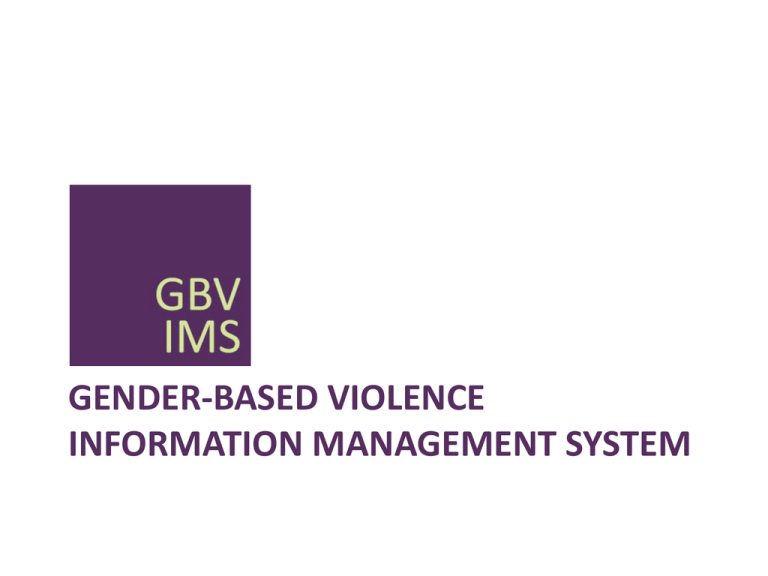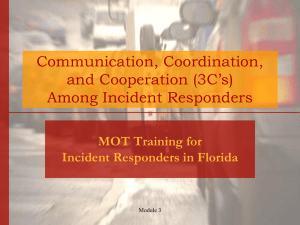
GENDER-BASED VIOLENCE
INFORMATION MANAGEMENT SYSTEM
• The GBVIMS was created by UNHCR, IRC and
UNFPA
• The GBVIMS global initiative is now governed by a
Steering Committee that includes UNFPA, IRC,
UNHCR, UNICEF and WHO
• IRC plays the role of ‘NGO Liaison’ on part of the
Steering Committee
GBVIMS OVERVIEW
The GBVIMS was created to:
• Address the prevailing issues in data management for
service providers (initially, mostly about quality – later,
more about ethics/safety)
• Help facilitate safe and ethical data sharing between
agencies to help inform the humanitarian community’s
response to GBV
GBVIMS PURPOSE
The GBVIMS was developed for:
• Service providers who deliver case management or health
services to GBV survivors in a humanitarian context.
• Agencies responsible for coordinating the humanitarian
response to GBV in humanitarian settings.
What the GBVIMS Can Do
• Allows service providers and coordination mechanisms to
better understand the GBV cases being reported
• Enables actors to safely & ethically share data
GBVIMS PURPOSE
•
•
•
•
Poor quality of data – comparing apples to oranges
Manual analysis of data – prone to errors
Casual approach to storing data
Sharing client data without their informed consent
or knowledge
• Sharing too much data (i.e. intake forms)
• Sharing identifying data
PERSISTENT PROBLEMS WITH GBV DATA
Service provision must be available to GBV survivors if data is to be gathered from
them
Survivor/incident data must be non-identifiable
Survivor/incident data can only be shared with the informed consent of the client
Client case files (i.e. intake or incident report forms) are only shared within the
context of a referral and with the consent of the survivor
Client data must be protected at all times and only shared with those who are
authorized
An agreement must be established in collaboration with service providers to
determine how data will be shared, protected, used and for what purpose –
before data is shared
EXAMPLES OF GOOD PRACTICE
THE GBVIMS CAN HELP ENSURE YOUR
ORGANIZATION ADHERES TO
GOOD PRACTICE
(AND GENERATES GREAT DATA!)
• NOT a case management tool – snapshot at
the time of report
• NOT to be used as a data collection outside
of the scope of service provision(i.e. by
researchers, surveyors or human rights
monitors)
• Does NOT generate prevalence data
WHAT THE GBVIMS IS NOT
1.
2.
3.
4.
Incident Classification Tool
Intake and Consent Form
Incident Recorder (excel)
Information Sharing Protocol
GBVIMS TOOLS
1
8%
31%
3
2
4%
55%
1%
500
393
400
300
200
100
1
Intake and Consent Form: collects information
from survivors and protects survivor’s control over
their information.
2
GBV Classification Tool: standardizes GBV
incidents making data easy to compile, compare,
and analyze.
3
Incident Recorder: an excel database designed
to gather corresponding information from the
intake form. The incident recorder automatically
generates data and allows for customized
analysis.
4
Information
Sharing
Protocol
Template:
regulates the sharing of GBV data with other
actors such as coordinating agencies.
0
4
7
133124
55
44
8
33
GBVIMS Data Informs
1%
Reports &
Proposals
Program
Design
Advocacy
Type of incident/violence:
(Select only ONE)
Rape
Sexual Assault
Physical Assault
Forced Marriage
Denial of resources, opportunities or services
Psychological/ Emotional Abuse
GBVIMS CLASSIFICATION TOOL
1. Did the reported incident involve penetration?
If yes classify the incident as “Rape”.
If no proceed to the next incident type.
2. Did the reported incident involve unwanted sexual
contact?
If yes classify the incident as “Sexual Assault”.
If no proceed to the next incident type
ETC.
GBVIMS CLASSIFICATION TOOL
A 41 year old widow’s home was claimed by her
husband’s family upon his death. She was beaten until
she collected a few belongings and left.
1 Did the reported incident involve penetration?
Did the reported incident involve unwanted sexual
2
If ‘No’
If
‘Yes’
contact?
Did the reported incident involve physical
3
If ‘No’
assault?
If
‘Yes’
If
‘Yes’
Rape Sexual Physical
Assault
Assault
STOP
8%
4%
31%
55%
1%
500
393
400
300
200
100
0
FLOW OF DATA
7
133124
55
44
8
33
GBVIMS Data Informs
1%
Reports &
Proposals
Program
Design
Advocacy
1.
2.
3.
4.
5.
6.
ADMINISTRATIVE INFORMATION
SURVIVOR INFORMATION
DETAILS OF THE INCIDENT
PERPETRATOR INFORMATION
PLANNED ACTION
ASSESSMENT POINTS
THE INTAKE FORM
• Primary data collection tool - Collects all data necessary for the optimal
functioning of the Incident Recorder
• The order of the form and all categories match the data columns found in
the Incident Recorder, making data entry as easy as possible
• Limited fill-in-the-blank entry, to save time on data entry and avoid errors
(uses tick boxes)
• Systematized definitions and categories ensures a minimum data set
collected by all providers; some fields are customizable
• Needs to be securely stored
• Not to be shared except in the context of a referral and with the consent of
the survivor
KEY CHARACTERISTICS OF THE INTAKE FORM
Purpose of the Incident Recorder
• Safely stores standardized data (comparing
apples to apples)
• Facilitates data entry and analysis
• Enable sharing of quantifiable elements of
anonymous incident data
• Create aggregate statistics to determine
correlations between characteristics and
circumstances of GBV incidents
INCIDENT RECORDER
• Based in Microsoft Excel
• No learning new software programs
• If you have never used Excel before, you will
only need to learn a few easy commands to
use the Incident Recorder
• Easy to enter data
• Anonymizes data for safe sharing
• Is protected
KEY FEATURES OF THE INCIDENT RECORDER
Perpetrator Survivor Relationship
1000
Housemate
Intimate Partner, 453
Family Friend
Intimate Partner
100
Other
69
Family
26
Schoolmate
13
12
10
Service Provider
4
4
4
Stranger / Unknown
2
1
1
Supervisor / Employer
Teacher / School Official
Stage of Displacement at time of Incident
Not Displaced /
Home Community
81%
During Refuge
3%
PostDisplacement
15%
During Flight
1%
• Key to Letting Data Flow
• Protocols clarify and enforce:
• what data will be shared
• for what purpose
• who compiles the data
• who has access the compiled statistics and for what
purpose
• All ethical and safety issues must be considered before
sharing data – including consent
INFORMATION SHARING PROTOCOL
• Website: www.gbvims.org
• Resources: User Guide, Rollout Guidelines,
Facilitator’s Guide, and Data Analysis ELearning Tool
• Minimum technical support available via the
GBV Steering Committee(gbvims@gmail.com)
and Skype (gbvimshelp)
AVAILABLE RESOURCES









